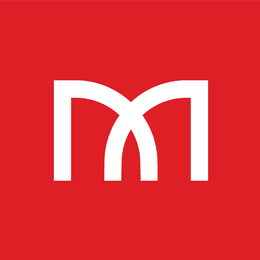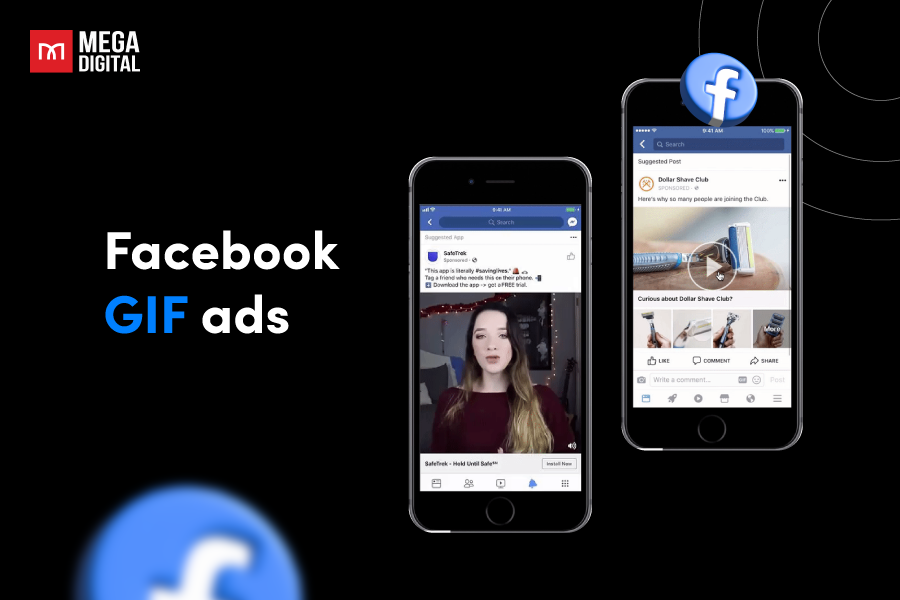Get to know Google Ad Rank with this comprehensive guide. Seize the chance to learn practical tips for increasing your Ad Ranking, such as updating your ad relevance, optimizing landing pages, and using ad extensions. Whether you’re new to advertising on Google or an experienced user, this guide will help you understand it well.
What is Google Ad Rank?
“What is Ad Rank in Google Ads?” Google Ad Rank is the position of your ad on the Google search results page based on a combination of factors. Advertisers bid to display their ads in Google’s auction system, but the highest bidder doesn’t always win the top spot. Instead, Google also considers the advertiser’s Ad Rank, which takes into account the ad’s relevance and expected click-through rate. The top position is for The ad with the highest Ad Rank.
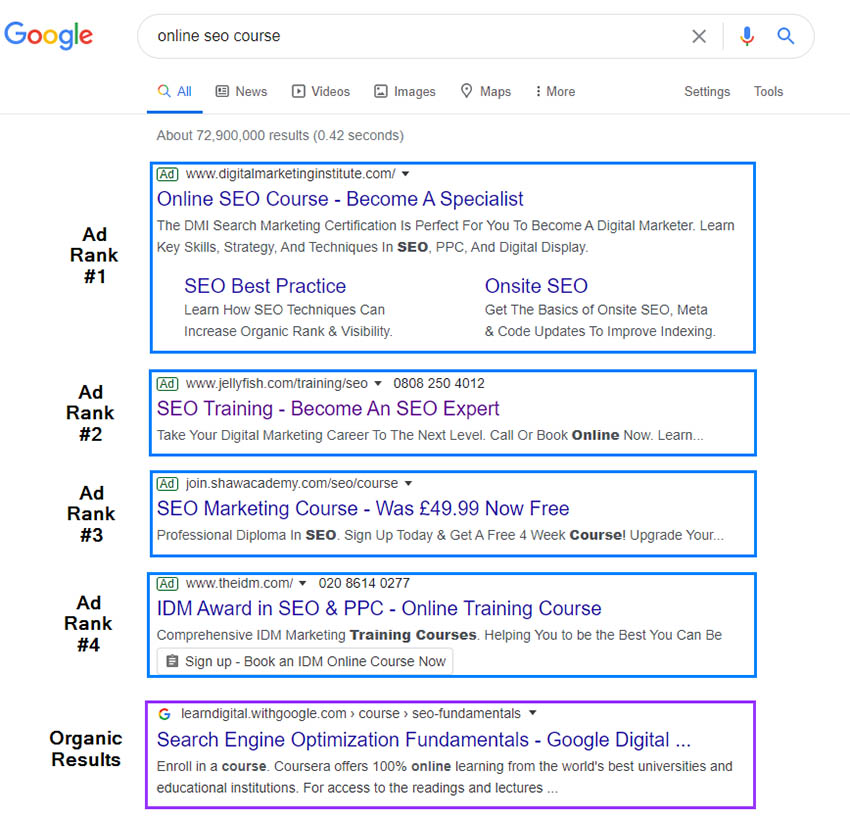
When consumers search on the Google search results page, the likelihood of clicking on the advertising above is substantially lower than that of clicking on the ads below. As a result, Ad Rank is essential to generate impressions and clicks fast and efficiently and to promote with a lot smaller expense.
How to calculate Ad Rank Google Ads?
Ad Rank considers bid amount, ad relevance, ad quality, and landing page experience during the auction. The position and order of your ad depend on competition, Ad Rank criteria, and searcher’s context. Google doesn’t disclose the algorithm, but experts suggest it involves a specific formula.
Ad Rank = CPC Bid X Quality Score

The Ad Rank algorithm determines ad visibility based on factors like ad format, quality, relevance, prominence, and click-through rates. A well-crafted, relevant ad with quality keywords can outperform higher-bid ads. The highest Ad Rank ad appears for a matching search query.
To rank higher on search engines, optimize your website with relevant keywords, quality content, backlinks, and a seamless user experience. This improves visibility to potential customers.
What main factors affect Ad Rank in Google Ads?
Yet, Google Ads is not like a simple auction; it operates on a more complex formula that changes regularly. If it had been a simple auction, the campaign with the most bids would have been ranked first. However, this is not the case. Many additional elements (as stated above) influence the rating of an ad or campaign.
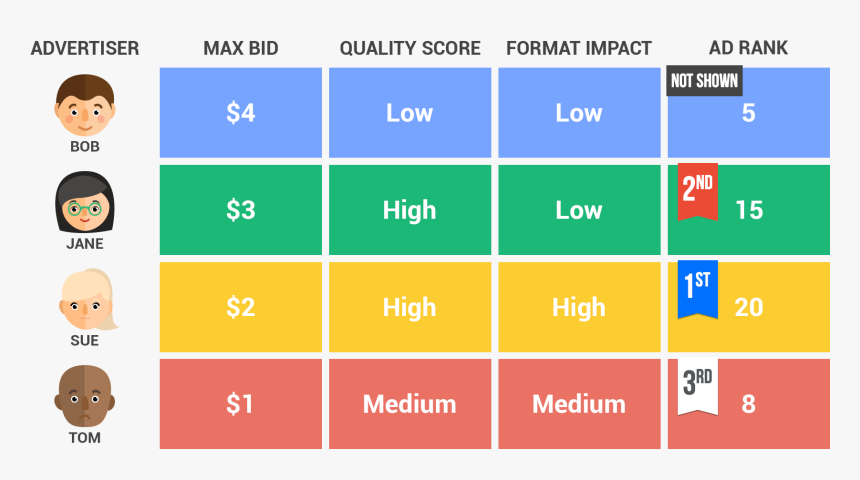
To summarize, the main factors of Ad Rank include the following:
- Maximum Bid: The greatest sum the advertiser will spend per click for a certain term or keyword.
- Quality Score: It’s a rating on a scale of 1 to 10. Google determines the user experience with a particular ad campaign or landing page by assigning this quality score to various advertisements. The experience on the landing page, the relevancy of the advertisement, and the anticipated click-through rate are just a few of the many elements that determine an advertisement’s quality score.
- Ad format: Extra format elements like ad extensions can impact click-through rate. Conversion analytics assess the effectiveness of headlines, landing pages, and ads by matching visitors’ intentions. A high conversion rate suggests higher ad relevance and possibly a higher Ad Rank than competitors.
Other factors Google uses to determine Ad Rank
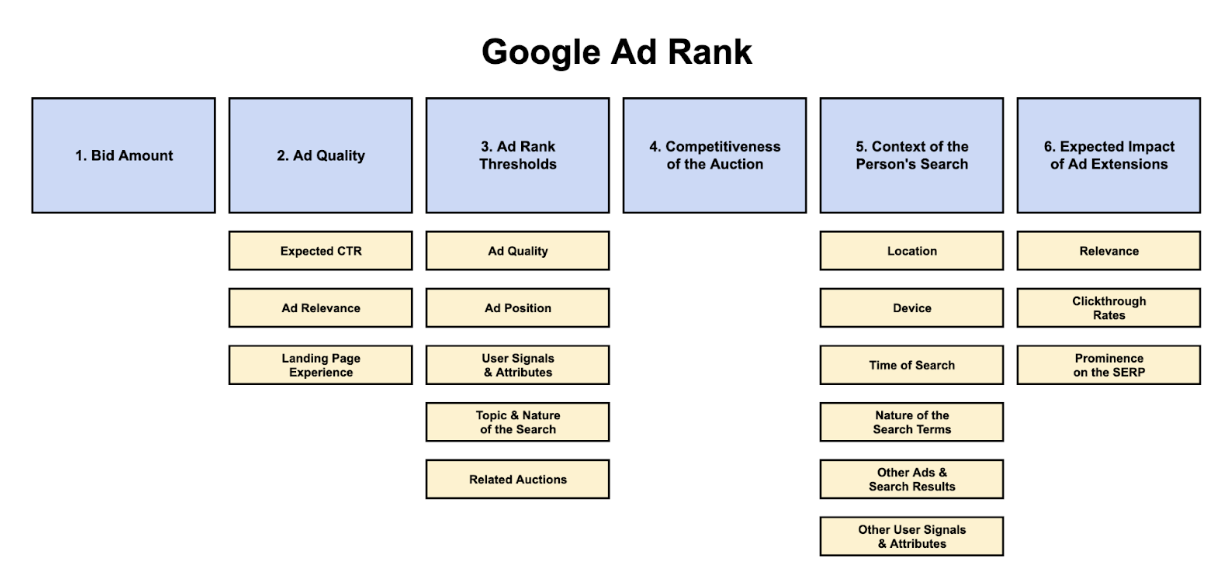
As mentioned, the Ranking of a Google ad is influenced by several factors, including the bid amount, ad quality, ad relevancy, and landing page experience, which are considered throughout the auction process. Both internal and external factors are crucial in determining your ad position.
Bid amount
The maximum cost-per-click (CPC) is the highest amount an advertiser is willing to pay to have their ad displayed in a specific position when a user searches for a particular keyword. There are both minimum and maximum thresholds for CPC.
For instance, if an advertiser sets a maximum CPC of $5 and the second-highest bidder has a maximum CPC of $4, the winning advertiser would pay $4.01 per click. This means the actual CPC an advertiser pays is usually less than their maximum bid and is based on the auction’s competitive landscape. Advertisers need to balance their maximum CPC with their budget to ensure they are not overspending on ads.
For more details on the bid amount and how to bid, check the below article:
>>> See more: The Best Google Shopping Bid Strategy and Tips to Improve ROAS
Ad Quality
Ad Quality is one of the key things we can influence. Three factors combine to determine an advertisement’s quality, or “Quality Score”.
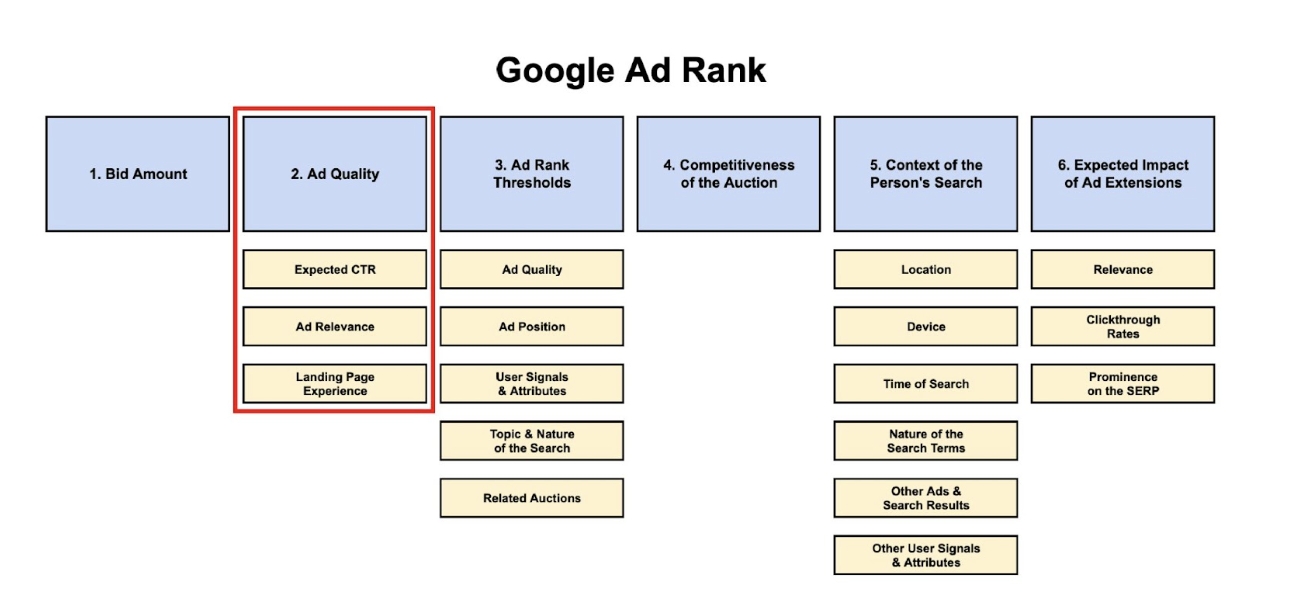
- The expected click-through rate (CTR): CTR is calculated for each term for which your ad is shown and gauges the chance that a searcher will click on it. There are three categories: Above average, average, and below average. If your advertising appears to be “below average,” consider revising the wording of your ads to make them more relevant to your target keywords.
- Ad relevance: The degree to which your keywords and advertising are connected. Additionally, it might be evaluated as “above average”, “average”, or “below average”. It is preferable to have many ad groups with precise, connected keywords rather than a few broad ad groups with many semi-related keywords.
- Landing page: Assesses the relevance and usefulness of your website’s landing page for a user who clicks on your ad. To improve a “below average” score, an advertiser can try using ad copy directly from the landing page. This will enhance the landing page experience and improve ad relevance and expected click-through rate (CTR).
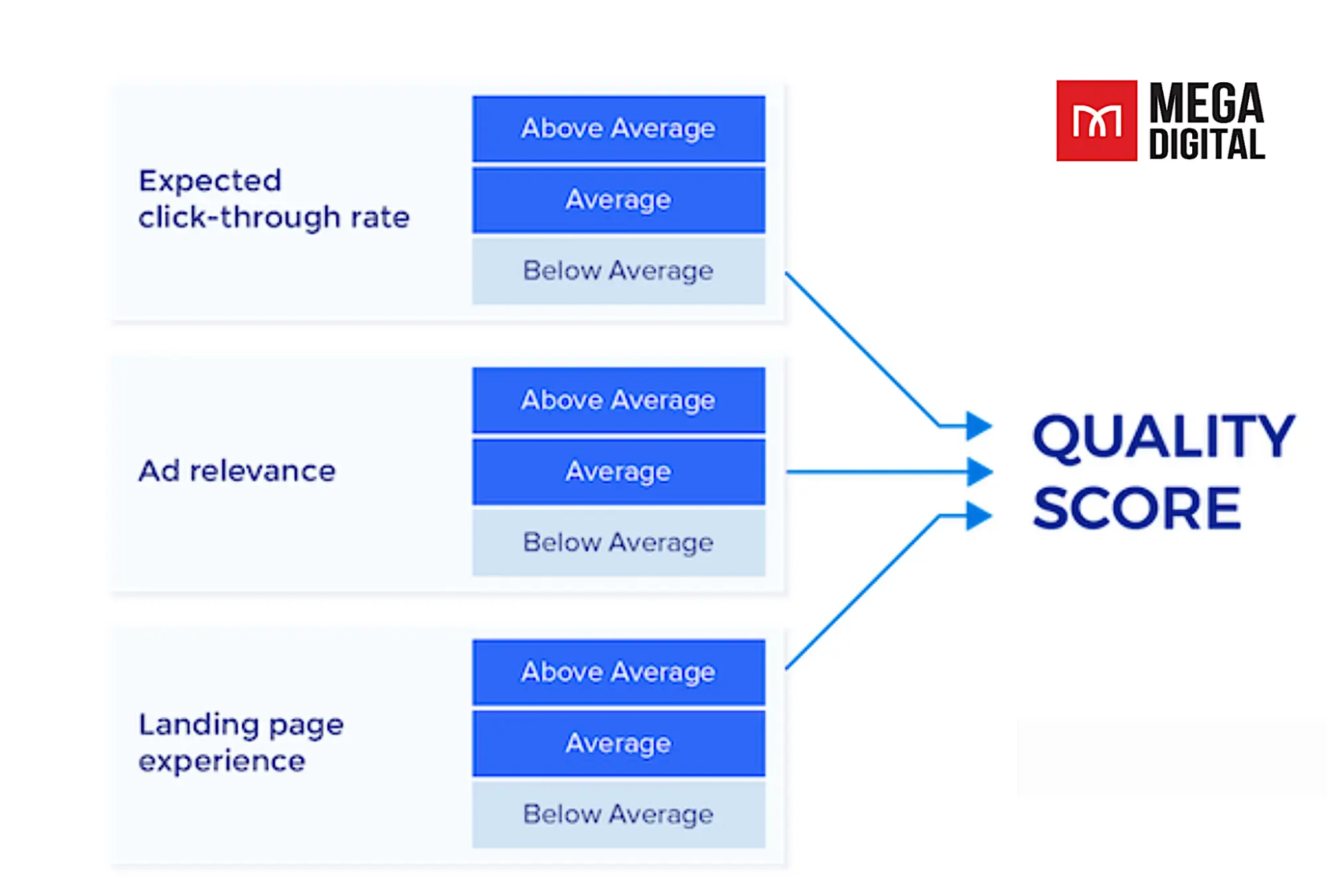
Google calculates an ad’s Quality Score by comparing its expected click-through rate, ad relevance, and landing page experience. Ad copy plays a significant role in determining ad quality, but searchers don’t always read it. Advertisers can use ad copy differently by incorporating keywords, search terms, and landing page text in headlines and descriptions. This strategy can result in higher grades for expected CTR, ad relevance, and landing page experience, ultimately leading to a Quality Score of 10.
Ad Rank threshold
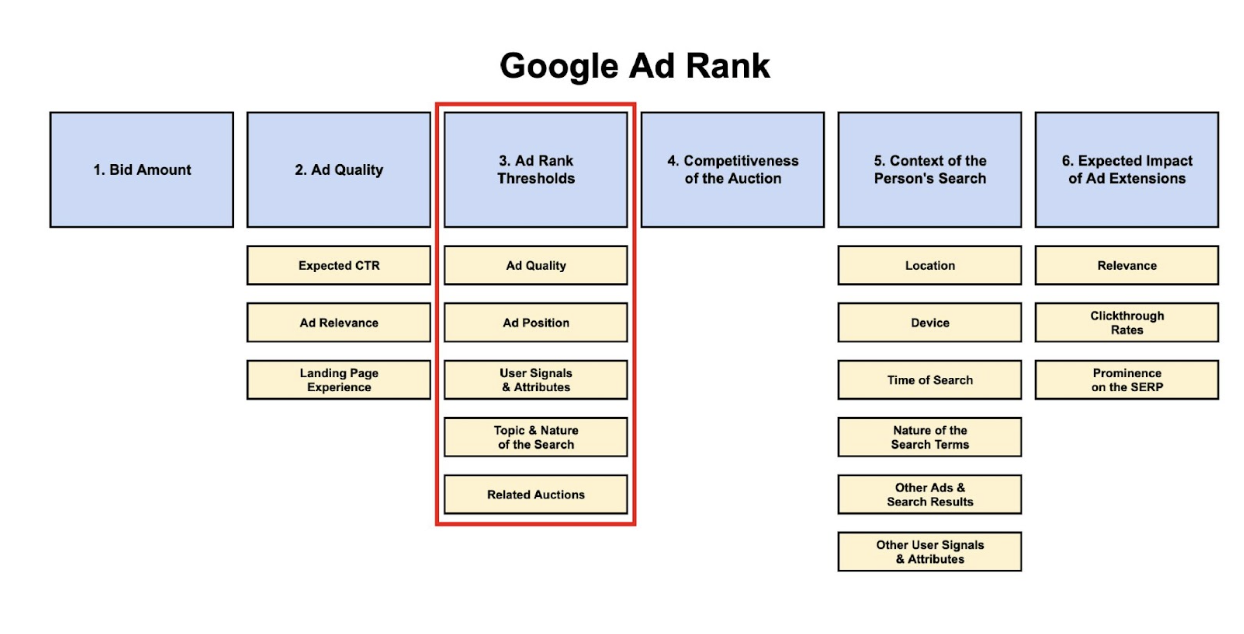
Google defines the Ad Rank threshold as “the reserve price of your ad.” Your ad will not appear if your bid is lower than the threshold. And if none of your rivals are eligible to appear, the threshold (reserve price) equals the cost of the click.
The SERP positions are tiers, and each tier has a minimum Ad Rank criteria that your ad must fulfill to compete for that position.
- Ad Quality: Google wants the searcher to have a “high-quality ad experience”. Lower-quality advertisements must meet higher requirements. Better advertising, in essence, Google Ads cost less for the same position.
- Ad Position: The higher the ad’s position on the page, the higher the threshold.
- User Signals & Attributes: The thresholds for this change depend on the search. The thresholds will be affected by the context of a person’s search (location, device, etc).
- Topic & Nature of the Search: The cost of a click varies depending on the sector, and the thresholds will differ from sector to industry.
- Related Auctions: The search terms used can also impact the threshold. For instance, the thresholds for a search for “Dove” shampoo and “Sunsilk” shampoo will be comparable.
Google Ad Rank criteria are mostly based on searchers’ queries and their results. Ad quality is one of the few things advertisers can influence, other than the budget. But there is still another aspect of Ad Rank that you can control.
Ad extensions’ expected impact
Ad extensions is a free way to improve Ad Rank, as Google considers their expected impact on ad performance. By increasing click-through rates (CTR), ad extensions may also improve expected CTR, boosting quality score and Ad Rank. However, the introduction of Performance Max campaigns has complicated the Ad Rank equation, making it difficult to determine which campaign type takes priority.

Ad extensions are a free and effective way to improve your ads’ Ad Rank. And, if you’re running both a Performance Max campaign and another type of campaign (such as a search or display campaign), make sure you’re taking advantage of all available ways to improve your Ad Rank.
Optimize ad quality metrics like expected CTR, ad relevance, and landing page experience. Use relevant keywords and content to boost Quality Score and Ad Rank. Use ad extensions to enhance ad performance and visibility.
Finally, we will analyze two of the factors which are out of our control and don’t require spending any money.
Competitiveness of the Auction

The competitiveness of an ad auction is a factor that is beyond the control of advertisers. Some industries tend to be more competitive than others, which can be due to the number of advertisers vying for ad space in a particular auction and the cost per click. While switching to a less competitive industry is not a feasible option for most advertisers, it’s essential to understand the competitive landscape of your industry and adjust your advertising strategies accordingly.
For example, the financial services and insurance industries are often highly competitive and have some of the highest cost-per-click rates, as there are many players competing for limited ad space. Conversely, agriculture, forestry, and fishing industries are often less competitive, resulting in lower cost-per-click rates.
Context of a person’s search
This includes information on the searcher’s location, device, when they started the search, etc. Two people can search for the same item but in different countries with different languages. All of which you may and need to be adjusting your bids for based on previous results. There isn’t much an advertiser can do with this to raise Ad Rank, though, if they don’t want to spend more money.
As a leading Google partner in the APAC region, Mega Digital offers the best Google Shopping Advertising services. Contact us to get your ad ranked 1st in the SERP!
How to improve Google Ads Ranking
After understanding all the elements that may affect your ad rank, increasing ad quality is one of the most important aspects. How can this be accomplished? When increasing your ad rank, we recommend concentrating on three major factors: click-through rate (CTR), ad relevancy, and landing page quality.
Click-through-rate (CTR)
CTR measures how many people click on your ads compared to the number of times they are shown. To improve your CTR, create compelling ad copy, incorporate relevant ad extensions, and use negative keywords to filter out irrelevant traffic.
Focus On Ad Extension Content
Ad extensions can be a powerful tool to increase CTR and improve Ad Rank. To improve the content of your ad extensions, start by analyzing the search queries that trigger your ads and tailor your extensions to be as relevant as possible to those queries.
In addition, utilize all relevant ad extensions, such as site links, callouts, and structured snippets. Ensure that the information in your ad extensions is accurate, up-to-date, and compelling to encourage clicks.
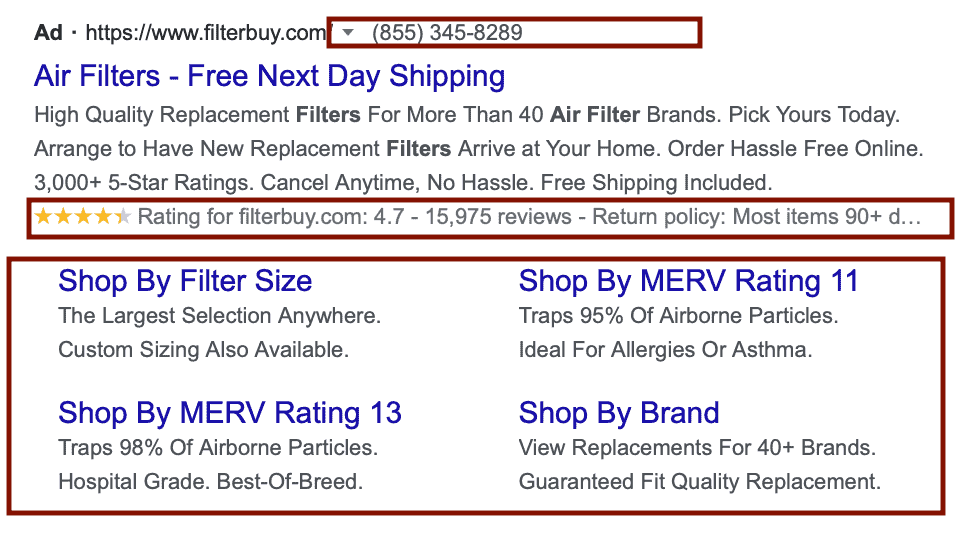
Ad relevance
Ad relevance refers to how well your ad matches the user’s search query. A highly relevant ad is more likely to attract clicks and result in conversions. To improve ad relevance, conduct SERP research to gain insights into the user’s search intent and create ads that address their needs and preferences. Another advice is to monitor and analyze your ad performance data regularly. Use this data to identify areas for improvement and optimize your campaigns accordingly. This includes adjusting bids, refining targeting, testing new ad copy, and experimenting with different ad formats.
Landing page quality
To improve the quality of your landing page, it’s important to ensure that it’s relevant, user-friendly, and optimized for keywords. To achieve this, follow these best practices.
Ensure ad-landing page relevance
Ensuring your landing page is directly related to your ad’s content is crucial. For example, if your ad is about a specific product, your landing page should provide information about that product and not something else. This will ensure visitors find what they are looking for and are more likely to convert.

Optimize page loading time
An online page that takes over three seconds to load will lose 40% of its visitors. Put another way, your paid visitors won’t patiently wait for your landing page to load for more than five seconds. Use tools like Google PageSpeed Insights to evaluate your landing page speed and make improvements accordingly. This will improve user experience and contribute to a better Google Ads Quality Score.
Customize your landing page for each ad
Creating a unique landing page for each Google ad is essential to enhance ad-landing page relevance. Consider using a landing page template and customize it with unique imagery and copy for each ad. This will improve user experience and increase the chances of conversion.
For example, if you’re running an ad campaign for a clothing brand, make sure that your landing page features products related to the ad, such as shirts or dresses. Also, ensure that the page loads quickly and customize the page with the ad’s specific messaging, such as a promotional offer or call-to-action. These best practices can improve your landing page quality, increase user engagement, and drive more conversions.

Extra tips for your Ad Rank
- Bidding higher is the easiest approach to boost your ad rank and get more visitors. It may not be a practical alternative for small enterprises or those on a restricted budget. However, increasing your bids will allow you to enhance your ad rank quickly.
- Increase your CTR (click-through rate) by emphasizing certain perks and features. Ranking high is not the only element that influences the number of clicks. You could also produce more feature-rich advertisements highlighting your product or service’s primary benefits and characteristics.
- Create a specialized strategy by being more specific and relevant. Relevant advertisements ensure that a small and highly focused segment of your audience may engage with your business and its products or services. More accurate ad placements will bring in more quality leads.
- Create specific landing sites for various ad campaigns since Google keeps track of how each landing page is used instead of only looking at the advertisements on search result pages.
Final words
Mega Digital has guided you through all the things you need to know about Google Ad Rank. The article also provided useful tips to improve your ad position.
